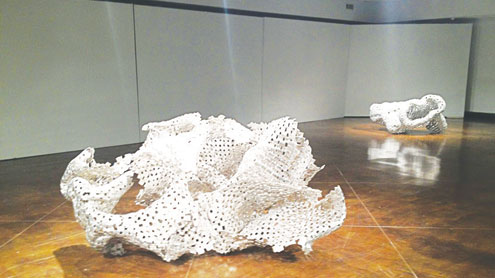 Craig Wedderspoon’s sculpture, “Fast,” demanded 10,000 two-inch aluminum squares and almost 800 hours of work. Before April 27’s storms, the 3-D metal quilt rested in the yard of another art professor, Steve Miller. Minutes after the tornado had hit Miller’s home, “Fast” had taken flight, landing a mile away on McFarland. It was altered and bent.
Craig Wedderspoon’s sculpture, “Fast,” demanded 10,000 two-inch aluminum squares and almost 800 hours of work. Before April 27’s storms, the 3-D metal quilt rested in the yard of another art professor, Steve Miller. Minutes after the tornado had hit Miller’s home, “Fast” had taken flight, landing a mile away on McFarland. It was altered and bent.
The UA art department, a close group of less than 30 faculty members and just over 200 undergraduates, was changed by the storm. They lost homes, works and friends.
Art instructor Tom Wegrzynowski didn’t recognize the shape in his window on April 27, 2011. As the dark mass consumed the sky, Wegrzynowski doubled back, joining his wife and two children in the hallway. This was routine—just another Alabama tornado. Then the noise came.
“It was like a freight train, growing louder and louder and louder,” said Wegrzynowski, an instructor of art at the University. “I knew we were going to get hit.”
A sudden change in pressure caused their ears to pop as 60-year-old pine trees, uprooted from the front yard, tore through the house. The pressure equalized, fresh pinesap filled their nostrils, and it was gone. On the edge of the storm’s path, most Arcadia residents were relatively lucky.
Steve Miller was on ground floor of Gorgas Library, ready to ride out the storm.
“But, suddenly, this one felt really bad, really unsettling,” Miller said, UA professor and coordinator of the MFA book arts program.
He had to get home. After driving to his house on Hillcrest, Miller and two friends hustled to the basement, hitting the ground seconds before the noise found them. Minutes later, they dug through dirt, glass and nails, emerging from the basement to an unrecognizable landscape.
“Nothing in all directions,” Miller said. “Like a nuclear blast.”
But art professors lost more than their homes that afternoon. Their student and friend, Morgan Sigler, died in the storm. A senior majoring in graphic design, Sigler stood out in her classes.
“Sculpture is a community-based activity; so, when one of our own gets taken away, it leaves a big hole,” Craig Wedderspoon, Sigler’s sculpture professor, said.
There’s no question that these teachers and many others have had to cope. But, thankfully, they haven’t been alone. Wedderspoon, Sigler’s sculpture professor, helped salvage the remains of his colleague’s home in Hillcrest and his sculpture students, equipped with chainsaws, helped clear debris in Arcadia.
Wegrzynowski still paints, Wedderspoon still bends iron and clay, and Miller still sews books and presses prints. In fact, despite only recovering one torn page of a 365-page work in the wreckage, Miller saw beauty, using the page to form a print called “Tornado Leaf.”
“Things started to clarify: My friends were all still there, and the program I love was still there.” Miller said. “Now, I’m attacking new projects.”
The transition has been harder for some.
“So many people lost so much; so many needed help and here I am trying to make art,” Wedderspoon said. “I felt like an ass going back to work.”
In their returns to normalcy, all three professors have felt touched by Sigler. Wegrzynowski had kept one of her practice sketches for over a year before her death. He’s since had the opportunity to return the piece to her family.
While cleaning Sigler’s workstation in the studio, Wedderspoon and his students found horsehair, which Sigler had intended to use to imprint textures on her pottery. Inspired, her friends and classmates molded their own pieces with her material, presenting the finished works to her family.
Even Miller, who never taught Sigler, feels a connection through his friendship with Wedderspoon and his fascination with “Fast.”
“The piece changed during its flight,” Miller said. “It became connected to Morgan in a certain way.”
Wedderspoon believes that “Fast,” broken after its flight, is a brutal reminder of the destruction—the destruction the Sigler family experienced on a profound level. But despite the wear, “Fast” is also a testament to integrity. Like the UA art department and the Tuscaloosa community, it was engulfed by a storm. Its strength was tested. And it’s still here, one year later.









